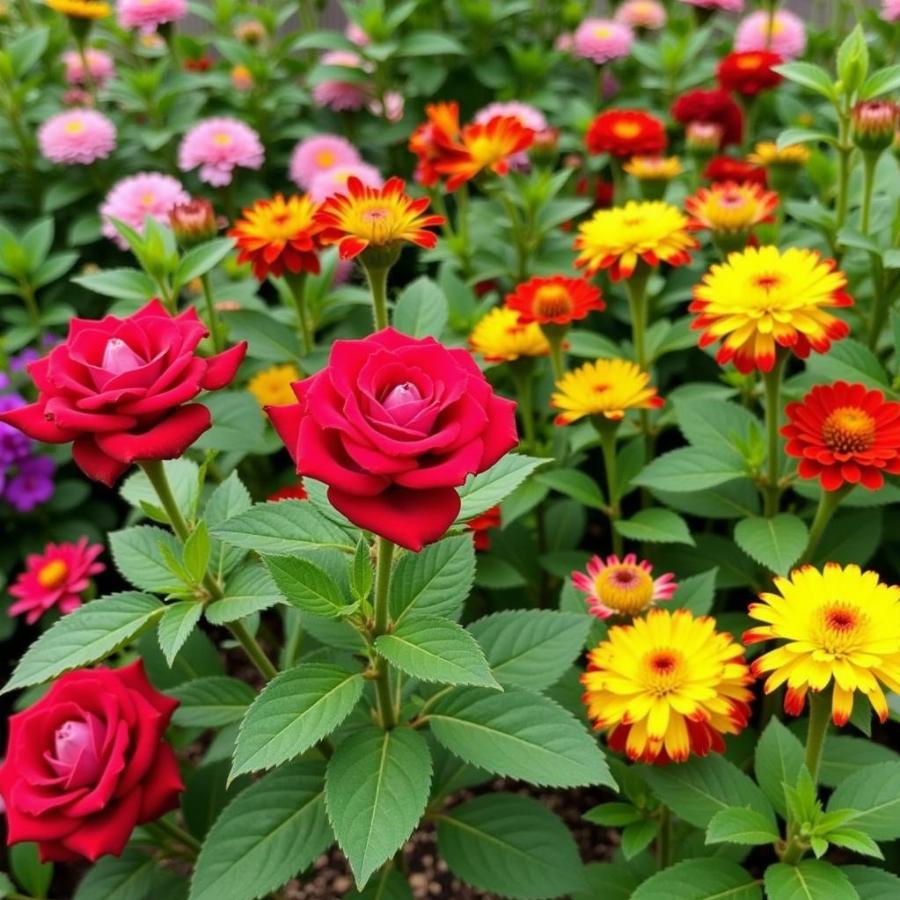Knowing which flowers are safe for dogs is crucial for responsible pet ownership. Many common blooms can pose serious health risks to our furry friends, causing anything from mild stomach upset to severe toxicity. This guide provides a comprehensive overview of flowers safe for dogs, helping you create a beautiful and safe environment for your canine companion. Choosing dog-friendly flora ensures your pup can enjoy the garden without risking their health. Let’s dive into the world of safe and stunning blooms!
Dog-Friendly Flowers: A Blooming Paradise
Creating a vibrant garden that’s safe for your dog is easier than you think. Numerous beautiful flowers pose no threat to canine health. Roses, for instance, are a classic choice and generally safe, although thorns should be removed to prevent injury. Sunflowers, with their cheerful faces, are another excellent option, bringing a touch of summer to your dog-friendly space. Zinnias, known for their vibrant colors and easy care, are also a safe bet. Other safe choices include snapdragons, gerber daisies, and orchids. These beautiful blooms add color and fragrance to your garden without compromising your dog’s safety. Remember, even with safe flowers, it’s best to discourage your dog from munching on them regularly, as large quantities can still cause digestive upset.
 Roses, Sunflowers, and Zinnias: Safe Flowers for Dogs
Roses, Sunflowers, and Zinnias: Safe Flowers for Dogs
Toxic Flowers: Recognizing the Dangers
While many flowers are safe, several pose significant risks to dogs. Lilies, for example, are extremely toxic, even in small amounts. Ingestion can cause kidney failure and even death. Tulips and daffodils also contain toxins that can lead to vomiting, diarrhea, and other serious health problems. Other dangerous flowers include azaleas, rhododendrons, and sago palms. Familiarizing yourself with these toxic blooms is crucial for preventing accidental ingestion. If you suspect your dog has ingested a toxic flower, contact your veterinarian immediately.
Creating a Safe Garden for Your Pup
Designing a dog-friendly garden involves more than just choosing safe plants. Consider using raised beds or designated areas for your flowers, making them less accessible to your furry friend. Regularly inspect your garden for any toxic plants that may have sprung up unexpectedly. Proper fencing can also help prevent your dog from wandering into unsafe areas. Supervise your dog when they are in the garden, especially if they are prone to nibbling. Teaching your dog a “leave it” command can also be incredibly helpful in preventing them from ingesting potentially harmful plants. portable play yard for dogs might be a great temporary option for your playful pup.
What if My Dog Eats a Toxic Flower?
Swift action is crucial if your dog ingests a toxic flower. Contact your veterinarian or an animal poison control center immediately. Provide them with as much information as possible, including the type of flower ingested, the amount consumed, and any symptoms your dog is exhibiting. Early intervention can significantly improve the outcome.
Frequently Asked Questions about Flowers Safe for Dogs
- Are all roses safe for dogs? Yes, most roses are considered non-toxic to dogs, but thorns can cause injury.
- What should I do if my dog eats a lily? Contact your veterinarian immediately, as lilies are highly toxic to dogs.
- Can I use fertilizers in a dog-friendly garden? Choose pet-friendly fertilizers to avoid exposing your dog to harmful chemicals.
- Are there any safe herbs for dogs? Yes, many herbs, such as basil, rosemary, and thyme, are safe for dogs. Find out more about non toxic flowers for dogs.
- How can I keep my dog from eating my flowers? Training, designated areas, and supervision can help deter your dog from munching on your flowers. Check out our article on bucket hat for dogs for some stylish sun protection.
Expert Insights
Dr. Emily Carter, a renowned veterinary toxicologist, emphasizes, “Prevention is key when it comes to protecting your dog from toxic plants. Knowing which flowers are safe and taking appropriate precautions can create a beautiful and safe environment for your beloved companion.”
Dr. David Miller, a veterinarian specializing in canine health, adds, “If your dog ingests a potentially toxic flower, time is of the essence. Immediate veterinary attention can be life-saving.” If you are concerned about the corn dog plant and its potential toxicity, be sure to consult with your vet.
Conclusion
Creating a beautiful and safe garden for your furry friend requires careful consideration of the plants you choose. By selecting flowers safe for dogs and taking appropriate precautions, you can ensure your pup enjoys the outdoors without risking their health. Remember, a little research goes a long way in creating a blooming haven for both you and your canine companion. For further information regarding hibiscus and its safety for dogs, please see our article are hibiscus toxic to dogs.
Further Reading and Related Questions
- What are the best low-maintenance dog-friendly plants?
- How can I train my dog to stay away from specific plants?
- What are some common signs of plant poisoning in dogs?
Beaut Dogs is your go-to resource for all things dog-related, providing expert advice and information on breeds, care, and much more. When you need assistance, reach out to us via Email at [email protected] for detailed and accurate answers from Beaut Dogs. Visit us at https://beautdogs.com!